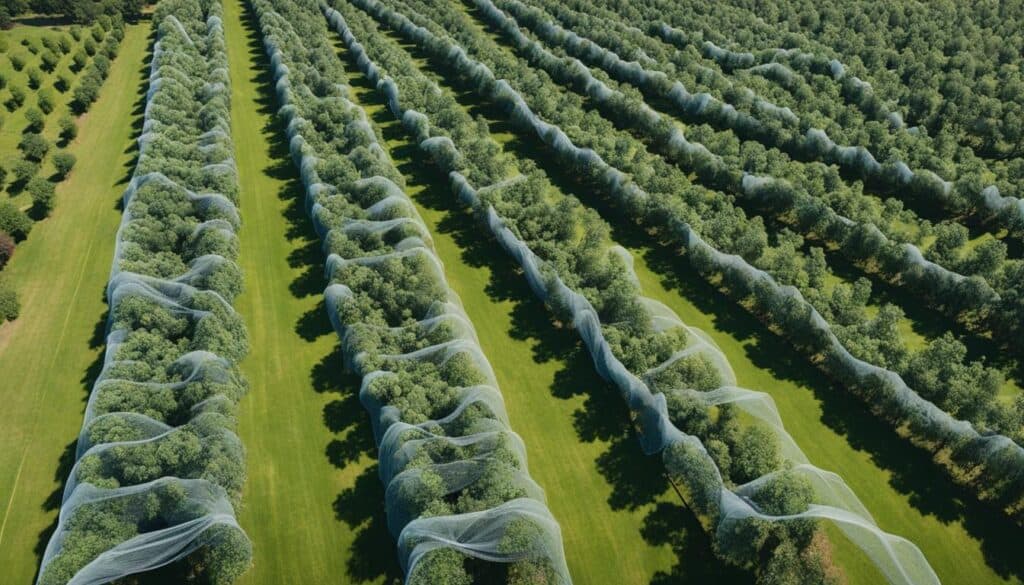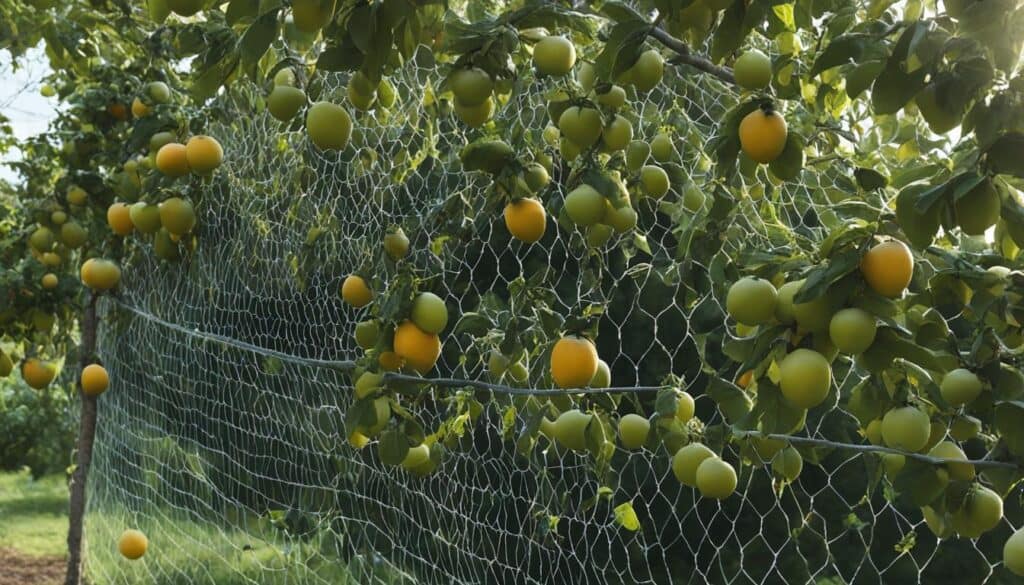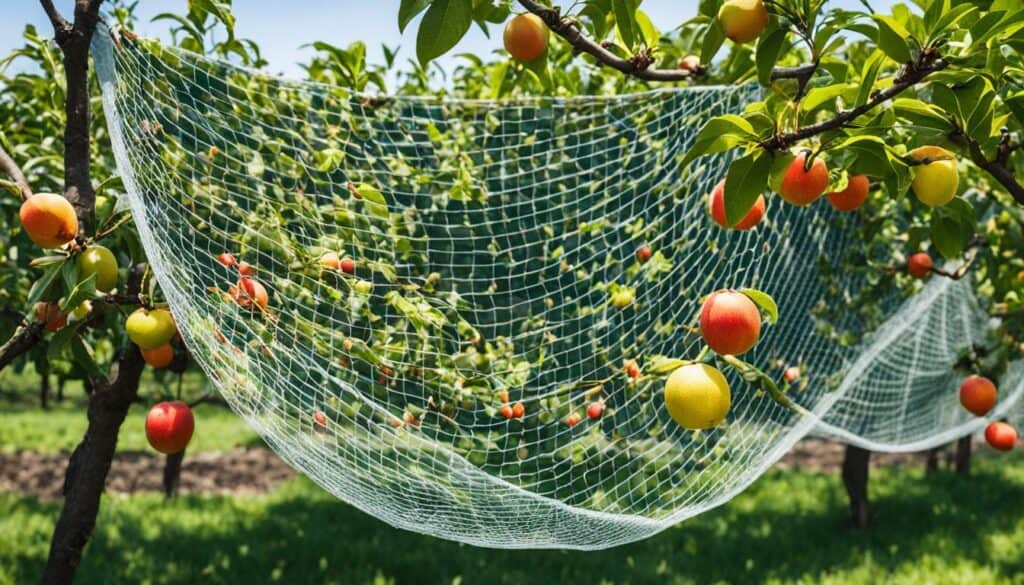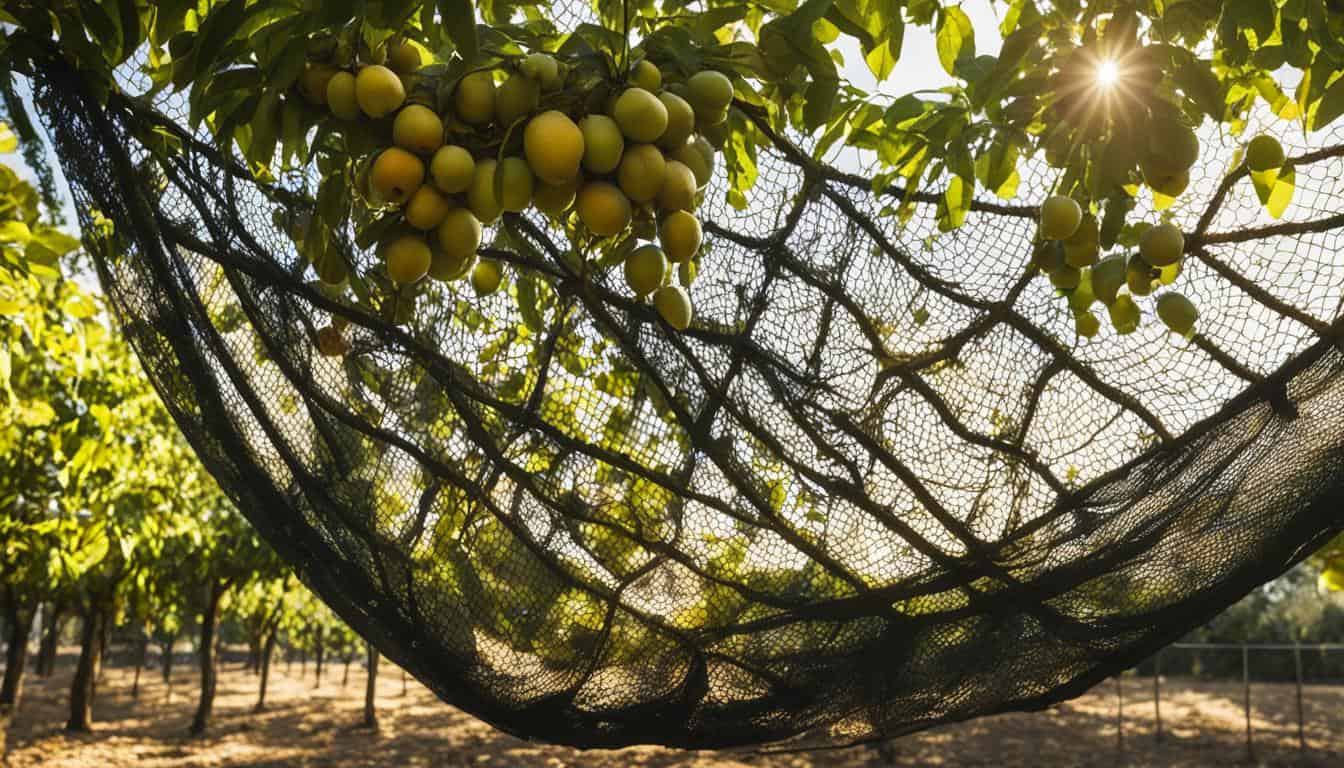Growing your own fruit can be a rewarding experience, but it’s disheartening when pests and birds ruin your harvest. That’s where large fruit tree netting comes in. With its heavy-duty and durable design, this netting provides a protective barrier around your fruit trees, keeping pesky pests and birds at bay.
Whether you have an orchard or a small garden, using bird netting for fruit trees is an effective method for fruit tree bird protection and fruit tree pest control. By creating a physical barrier, you can prevent birds from pecking at your ripe fruit and pests from damaging your harvest. It’s time to take control and protect the fruits of your labor.
Key Takeaways:
- Large fruit tree netting is a durable and effective solution for protecting your harvest.
- Bird netting for fruit trees keeps pesky birds from damaging your fruit.
- Using durable fruit tree netting ensures long-lasting protection for your trees.
- Orchard netting and garden netting are essential for safeguarding your fruit trees.
- Fruit tree netting provides a reliable barrier for bird protection and pest control.
Choosing the Right Fruit Tree Netting Material
When it comes to selecting the perfect fruit tree netting, there are several factors to consider. From the material to the hole size, each aspect plays a crucial role in the effectiveness of your netting. Let’s dive into the key elements to keep in mind:
Material Matters: Polyethylene vs. Polypropylene Netting
Fruit tree netting is commonly made from two materials: polyethylene and polypropylene. Both options have their advantages, so let’s take a closer look at each:
| Material | Advantages |
|---|---|
| Polyethylene Netting | Durable and rot-proof |
| Polypropylene Netting | UV stabilized and resistant to direct sunlight |
Choosing a material with UV stabilizers is essential to ensure the netting can withstand prolonged exposure to sunlight without degrading quickly. Rot-proof netting, on the other hand, offers increased longevity but may still require replacement over time.
Hole Size and Shape: Finding the Right Fit
One crucial factor in fruit tree netting selection is the hole size. The goal is to prevent pests such as birds and insects from accessing the fruit while allowing sufficient light transmission for healthy growth. We recommend a mesh size of 1.5 to 2 inches to strike the right balance.
Additionally, consider the shape of the netting pattern. Opting for square-shaped netting rather than diamond-shaped minimizes the risk of entanglement for wildlife, making it a safer choice all around.
Flexibility: Ensuring Safety for Birds and Animals
Flexible netting is a must when it comes to protecting both your fruit and wildlife. Animals that may become entangled, such as birds, bats, or squirrels, can escape more easily with flexible netting.
I highly recommend choosing netting that is flexible, as it reduces the risk of harm to wildlife and allows them to navigate their surroundings safely.
Remember, our goal is to protect our harvest without causing harm to the natural ecosystem.
Visual Appeal: A Beautiful and Functional Solution
Now that you have all the essential information, it’s time to find the perfect fruit tree netting that combines functionality and visual appeal. Look for high-quality netting that meets all the above criteria. Keeping your fruit trees protected has never been easier!
With the right fruit tree netting material, you can ensure the safety of your harvest and contribute to the well-being of local wildlife—while adding a touch of charm to your garden or orchard.
Benefits of Fruit Tree Netting
Fruit tree netting offers numerous advantages for growers. By effectively netting fruit trees, you can protect your precious harvest, keep the fruit clean, facilitate harvesting, and safeguard against birds and insects. There are different types of netting available, including bird netting and insect netting, that can provide comprehensive protection for trees and gardens.
Firstly, fruit tree netting acts as a barrier that shields your fruit trees from birds and other animals, preventing them from stealing valuable ripe fruit. This not only preserves the quantity of your yield but also safeguards the quality of the fruit itself.
The netting also plays a crucial role in keeping the fruit clean, particularly in the case of fruits like apples that are susceptible to staining. By effectively creating a protective barrier, fruit tree netting serves as a shield against environmental factors that can soil or damage the fruit.
Furthermore, netting provides support in keeping the fruit attached to the branches until they are ready for harvest. It avoids premature fruit drop caused by external factors such as gusts of wind or movements from birds and other animals. This makes the harvesting process much more manageable and efficient, ensuring you can gather your crops with ease.
Additionally, fruit tree netting is available in different varieties, such as bird netting and insect netting. Bird netting is designed specifically to deter birds from accessing and damaging the fruit, while insect netting acts as a barrier against pesky insects that can cause significant harm to plants and trees.
Key Benefits of Fruit Tree Netting:
- Protection of fruit trees from birds and other animals
- Maintaining clean and stain-free fruit
- Facilitating easier harvesting process
- Availability of specialized netting for bird and insect protection
With its diverse range of advantages, fruit tree netting is a valuable investment for any grower seeking to protect their harvest, maintain fruit quality, and ensure smooth harvesting operations.
I’ve seen a significant improvement in my harvest since I started using fruit tree netting. It keeps the pesky birds away and saves me from the disappointment of finding half-eaten fruit. Plus, my apples stay spotless thanks to the protective netting. Harvesting has become a breeze with the support of netting. I highly recommend it to all fruit growers!
Types of Fruit Tree Netting
When it comes to protecting different types of fruit trees, specific netting solutions are available to address the unique challenges faced by each variety. Let’s explore some popular fruit tree netting options:
Strawberry Netting
Strawberry netting serves as a barrier against pesky insects like earwigs and slugs that can cause damage to strawberry plants. By preventing these pests from reaching the strawberries, the netting helps ensure a bountiful and healthy harvest.
Blueberry Netting
Blueberry netting is designed to protect blueberries from birds and insects that are attracted to their delicious taste. By covering the blueberry bushes with netting, you can enjoy a higher yield of these flavorful berries.
Grape Netting
Grapes are a favorite among birds and other animals, making grape netting crucial for safeguarding your harvest. With grape netting in place, you can prevent birds and other wildlife from accessing your grapes, allowing them to fully ripen and reach their maximum potential.
Cherry Tree Netting
Cherry tree netting plays a vital role in protecting cherries from birds, which are known to peck at the fruit and reduce the overall yield. By installing cherry tree netting, you can enjoy a higher quantity and quality of cherries from your trees.
Citrus Netting
Citrus netting is specifically designed to protect citrus crops from fruit flies and bees, which can damage the fruits and reduce their market value. While providing protection, citrus netting also allows sunlight and air circulation to reach the trees, maintaining a healthy growing environment.
Apple Tree Netting
Apple tree netting is commonly used in orchards to keep birds away and increase fruit production. By preventing birds from accessing the apples, orchard owners can enjoy higher yields and preserve the fruits’ quality.
Each type of fruit tree netting offers unique benefits, ensuring your harvest stays safe and allowing you to enjoy the fruits of your labor. Choose the netting that best suits your specific fruit tree needs, and protect your harvest effectively.

| Netting Type | Main Purpose |
|---|---|
| Strawberry Netting | Protection against insects like earwigs and slugs |
| Blueberry Netting | Prevention of bird and insect damage |
| Grape Netting | Restriction of birds and animals from accessing grapes |
| Cherry Tree Netting | Shielding cherries from birds for increased yield |
| Citrus Netting | Protection against fruit flies and bees while allowing sunlight and air circulation |
| Apple Tree Netting | Bird deterrent to enhance fruit production |
Tips for Properly Installing Fruit Tree Netting
When it comes to protecting your fruit trees, proper installation of netting is essential. Follow these tips to ensure your netting provides optimal coverage:
- Timing is crucial. Cover your fruit trees after pollination, when the fruit starts to develop and is green in color. This ensures maximum protection against pests.
- Consider wildlife safety. When installing netting, be mindful of wildlife and ensure it does not harm or trap animals. Look for flexible netting that reduces the risk of entangling animals like bats and possums.
- Choose lightweight netting. Opt for lightweight netting to prevent damage to the tree. This makes installation easier and minimizes strain on the branches.
- Maintain proper ventilation. Ensure that the netting allows proper sunlight, moisture, and ventilation to reach the tree. This is important for the tree’s overall health and fruit production.
- Invest in high-quality netting. Look for netting that is anti-rip and rot-free, guaranteeing durability and long-lasting protection for your fruit trees.
By following these tips, you can effectively cover your fruit trees and safeguard your harvest against damage from pests and animals, while ensuring the well-being of the tree and its ecosystem.

Key Features to Consider When Choosing Fruit Tree Netting
When selecting fruit tree netting, several key features should be taken into consideration to ensure the best protection for your trees and wildlife safety. These features include the mesh size, hole width, flexibility, pattern, and the timing of covering fruit trees.
Mesh Size
The mesh size of the netting is an essential factor to determine which animals can pass through it. Small mesh sizes are effective in preventing birds from entering while still allowing smaller wildlife, such as squirrels, to pass through. By selecting the appropriate mesh size, you can effectively protect your fruit trees while ensuring the safety of wildlife.
Wildlife Safety
Ensuring wildlife safety is crucial when choosing fruit tree netting. The netting should be flexible to allow animals to fly or easily escape if they become entangled. It is important to select netting that minimizes the risk of harm to wildlife and provides a safe environment for both the trees and the animals.
Hole Width
The hole width in the netting is significant in preventing pests from entering while still allowing sufficient airflow and light transmission. Choosing a netting with an appropriate hole width will protect your fruit trees from unwanted visitors while maintaining the necessary conditions for healthy growth.
Pattern
The pattern of the netting can also impact wildlife safety. Diamond-shaped patterns in netting tend to be more dangerous for wildlife, as they can increase the risk of entanglement. Square-shaped patterns are generally safer and recommended for fruit tree netting to minimize any potential harm to wildlife.
Covering Fruit Trees
Timing is crucial when it comes to covering fruit trees. Ensuring that you cover your fruit trees at the right time is essential to protect them against damage and ensure optimal wildlife safety. Be mindful of the growth stages of your trees and cover them when the fruit is at the appropriate stage of development.
Considering these key features when choosing fruit tree netting will help you protect your trees effectively while ensuring the safety of wildlife. By selecting the right netting, you can create a balanced environment that encourages the growth of your fruit trees while coexisting harmoniously with the surrounding wildlife.
| Key Features | Consideration |
|---|---|
| Mesh Size | Small mesh sizes to prevent birds, while allowing smaller wildlife |
| Wildlife Safety | Choose flexible netting to allow wildlife to escape if entangled |
| Hole Width | Ensure sufficient airflow and light while preventing pests |
| Pattern | Prefer square-shaped patterns to minimize harm to wildlife |
| Covering Fruit Trees | Time the covering according to fruit development stages |

How to Protect Your Fruit Trees with Netting
Netting is a highly effective method for protecting your fruit trees from pests and ensuring a bountiful harvest. By installing netting before any damage occurs, you can prevent birds, squirrels, raccoons, and other animals from accessing your valuable crop. To make the most of netting, proper installation is crucial to ensure the safety of both your fruit and the wildlife in your area.
When installing netting, pay attention to the mesh size to allow passage for certain animals while preventing others. This will help you strike the right balance between protecting your fruit and preserving the biodiversity of your garden. Additionally, opt for flexible netting that reduces the risk of entanglement and allows animals to escape if they accidentally get caught.
Here’s a step-by-step guide to properly installing netting on your fruit trees:
- Measure the size of your tree or trees to determine the amount of netting needed. Ensure you have enough to fully cover the canopy without leaving any gaps for pests to sneak through.
- Install the netting before any significant fruit development to prevent pests from causing damage. This is usually after pollination and when the fruit is still green.
- Drape the netting over the tree, making sure it covers the entire canopy. Secure the corners to the trunk or branches using clips or zip ties.
- Use a heavy thread and needle to close any openings where the netting comes together, ensuring a tight seal to prevent pests from finding their way in.
- Inspect the netting regularly to ensure it remains in place and is not causing any harm to wildlife. Make necessary adjustments as needed.
By following these installation tips and using the right netting, you can effectively protect your fruit trees from pests, save your precious harvest, and preserve the wildlife in your garden.
Quotes:
“Installing netting on fruit trees is an essential step to protect your crops and ensure a successful harvest.” – Jane Peterson, Orchardist
“Properly installed netting provides a physical barrier that keeps pests at bay while allowing your fruit trees to thrive.” – James Monroe, Horticulturist
Fruit Tree Netting Installation Guide:
| Step | Description |
|---|---|
| 1 | Measure the size of your tree or trees to determine the amount of netting needed. Ensure you have enough to fully cover the canopy without leaving any gaps for pests to sneak through. |
| 2 | Install the netting before any significant fruit development to prevent pests from causing damage. This is usually after pollination and when the fruit is still green. |
| 3 | Drape the netting over the tree, making sure it covers the entire canopy. Secure the corners to the trunk or branches using clips or zip ties. |
| 4 | Use a heavy thread and needle to close any openings where the netting comes together, ensuring a tight seal to prevent pests from finding their way in. |
| 5 | Inspect the netting regularly to ensure it remains in place and is not causing any harm to wildlife. Make necessary adjustments as needed. |

Where to Find High-Quality Fruit Tree Netting
Finding high-quality fruit tree netting can be a challenge, especially if you can’t find it in hardware stores. But don’t worry, there are suppliers out there that offer a wide range of netting products for various industrial and agricultural applications.
When searching for reliable and durable fruit tree netting, look no further than EyouAgro. They are a trusted source for high-quality netting that is specifically designed to protect your fruit trees.
EyouAgro’s fruit tree netting is known for its excellent quality and functionality. It is carefully crafted to provide effective protection against birds and pests, ensuring your harvest remains intact. The netting is also designed to allow sunlight to reach your trees, promoting healthy growth.
With EyouAgro, you can rest assured that their netting is safe for the environment and meets the highest industry standards. Whether you have a small garden or a large orchard, their fruit tree netting is sure to meet your needs.
Take a look at the table below to see the benefits of choosing EyouAgro’s fruit tree netting:
| Benefits of EyouAgro’s Fruit Tree Netting |
|---|
| Durable and long-lasting |
| Provides effective protection against birds and pests |
| Allows sunlight to reach your trees |
| Safe for the environment |
As you can see, EyouAgro’s fruit tree netting offers numerous advantages for both small-scale and large-scale fruit tree protection. Don’t compromise on the quality of your netting when it comes to safeguarding your harvest. Choose EyouAgro for high-quality fruit tree netting that delivers exceptional results.

The Importance of Fruit Tree Netting for Harvest Protection
Fruit tree netting plays a vital role in protecting the harvest from pests and ensuring a bountiful yield. By utilizing fruit tree netting, you can prevent damage caused by pesky birds, bats, and other pests. This protective barrier acts as a shield against destructive creatures such as apple maggots and coddling moths, as well as birds that can peck at and destroy your precious fruit.
With the help of fruit tree netting, you can effectively control pests and safeguard your harvest, guaranteeing a successful and fruitful season. Let’s explore the benefits and significance of fruit tree netting in more detail:
1. Protect Your Harvest
Fruit tree netting serves as an essential defense mechanism, preventing birds, bats, and other pests from accessing your valuable fruits. It acts as a physical barrier, ensuring that your harvest remains intact and safeguarded from potential damage.
2. Prevent Pest Damage
One of the primary purposes of fruit tree netting is to protect your harvest from harmful pests like apple maggots and coddling moths. These pests can infest your fruit, causing significant damage and reducing the overall quality of your yield.
3. Ensure a Bountiful Harvest
Fruit tree netting plays a crucial role in ensuring a bountiful harvest. By keeping pests at bay, you can maximize your yield and enjoy a plentiful crop of delicious, healthy fruits.
4. Bird Protection
Birds can be a common threat to your fruit trees, pecking at the fruit and causing extensive damage. Fruit tree netting acts as an effective deterrent for birds, preventing them from accessing your delicious fruits and reducing potential losses.
5. Pest Control
Effective pest control is essential for maintaining the health and productivity of your fruit trees. Fruit tree netting provides a proactive solution by creating a barrier that keeps pests out, reducing the need for harmful pesticides and ensuring a more eco-friendly approach to pest management.
By incorporating fruit tree netting into your harvest protection strategy, you can enjoy the benefits of increased yield, reduced pest damage, and an overall healthier orchard. Protecting your harvest not only ensures the satisfaction of a successful season but also allows you to fully savor the fruits of your labor.
| Benefits of Fruit Tree Netting |
|---|
| Protects the harvest from pest damage |
| Safeguards fruits from birds and other pests |
| Reduces the need for harmful pesticides |
| Ensures a bountiful and healthy yield |
| Promotes eco-friendly pest control |
With the help of fruit tree netting, you can protect your harvest, prevent pest damage, and ensure the success of your fruit trees. Incorporate this essential tool into your orchard or garden to enjoy a bountiful and thriving harvest, while also taking steps towards effective pest control and wildlife conservation.
Conclusion
Large fruit tree netting is an essential investment for anyone looking to protect their valuable harvest and ensure a successful fruit tree season. The use of durable netting creates a reliable barrier against pests and birds, allowing your fruit to thrive and reach its full potential. It is imperative to select netting with wildlife safety features and employ proper installation techniques to safeguard both your crops and the surrounding wildlife in your orchard or garden.
When searching for the right netting, prioritize options that offer high-quality craftsmanship, durability, and functionality. This ensures that your netting will withstand the rigors of the seasons and serve its purpose effectively. By investing in large fruit tree netting, you can enjoy the benefits of a bountiful harvest while promoting the preservation of the natural ecosystem.
Protecting your harvest goes hand in hand with protecting the wildlife around you. Large fruit tree netting not only guards your crops against potential damage but also contributes to the well-being of local birds, bats, and other animals by preventing entanglement. With the right choice of netting and responsible installation, you can strike a balance between securing your harvest and preserving the integrity of the local wildlife population. So, make large fruit tree netting an integral part of your fruit tree care routine and enjoy the rewards of a successful and sustainable harvest season.
FAQ
What is fruit tree netting?
Fruit tree netting is a protective barrier made of durable material that shields fruit trees from pests and birds.
How does fruit tree netting protect my harvest?
Fruit tree netting acts as a barrier against pests and birds, preventing them from accessing and damaging the fruit.
Which pests can fruit tree netting protect against?
Fruit tree netting provides protection against pests such as apple maggots, coddling moths, and birds.
How do I determine the amount of netting needed for my tree?
Measure the height and width of your fruit tree to determine the amount of netting required.
When is the best time to apply fruit tree netting?
Wait until after blooming to wrap your tree and make any necessary tree maintenance before applying the netting.
How do I set up fruit tree netting on my tree?
Drape the netting over the tree and secure the corners to the trunk. Use heavy thread and a needle to close the openings where the net comes together.
What are the important features to consider when choosing fruit tree netting?
Consider the material, UV stabilization, rot-proofing, hole size, flexibility, and pattern of the netting.
What are the benefits of using fruit tree netting?
Fruit tree netting protects fruit from birds and other pests, keeps the fruit clean, facilitates harvesting, and prevents fruit from falling prematurely.
What types of netting are available for specific fruit trees?
There are different types of netting available for specific fruit trees, such as strawberry netting, blueberry netting, grape netting, cherry tree netting, citrus netting, and apple tree netting.
How can I properly install fruit tree netting?
Cover your fruit trees at the right time, ensure the netting does not harm or trap wildlife, use flexible and lightweight netting, and ensure proper sunlight, moisture, and ventilation reach the tree through the netting.
What key features should I consider when choosing fruit tree netting?
Consider the mesh size, wildlife safety, hole width, flexibility, and pattern of the netting when choosing the right one for your fruit tree.
How can I protect my fruit trees with netting?
Install the netting before damage starts, keep it in place until harvest, and ensure the netting is properly installed to prevent pests and protect wildlife.
Where can I find high-quality fruit tree netting?
You can find high-quality fruit tree netting from suppliers that offer a range of netting products for industrial and agricultural applications, such as EyouAgro.
Why is fruit tree netting important for harvest protection?
Fruit tree netting is crucial for protecting your harvest from pest damage, ensuring a bountiful harvest, and providing bird protection and pest control.





Leave a Reply